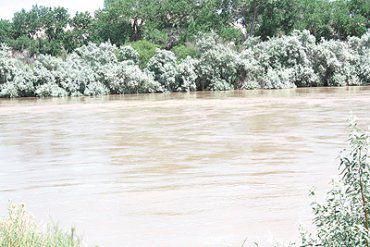Blue Castle Holdings, the company that wants to build Utah’s first nuclear power plant, received a favorable ruling in Seventh District Court last Wednesday. Judge George M. Harmond approved applications to divert water for the project from the Green River.
Blue Castle received approval from the State Engineer to lease water from conservancy districts in Kane and San Juan counties. The water – 29,600 acre-feet from Kane and 24,000 from San Juan – was originally intended for coal-fired plants in those counties. Those plants were never built.
Opponents of the proposed multibillion-dollar nuclear project had alleged that the State Engineer didn’t do an adequate job of assessing the feasibility of the project and its potential harmful impacts.
However, the judge noted in his 26-page decision that the court did not have the duty or the right to conduct its own investigation. He limited his analysis to the evidence submitted to the court.
Harmond also based the decision on state law and previous interpretations of other courts.
Point by point, the judge listed the factors that state law required of the decision:
Beneficial use
First, power generation would not interfere with more beneficial uses. Harmond found that legislation considers power generation as beneficial as culinary, agricultural or manufacturing use.
Evidence also showed that there is enough unappropriated water in the Upper Colorado River Basin and the Green River to accommodate the power plant’s need.
Environmental and recreational impacts are likely to be minimal. For instance, the judge cited historical evidence that 99 percent of the time, the water taken by the plant would narrow the river by less than 1.5 feet out 350 feet and reduce depth by less than 1.5 inches.
“There is no evidence that the proposed withdrawal would have an unreasonable impact (on) the natural stream environment,” the decision states.
Feasibility
The court was also required to consider if the plant was physically and economically feasible. Harmond found the evidence of feasibility, while not perfectly certain, was reasonable.
Physical feasibility has been demonstrated because the project has invested $17.5 million so far on geological, archaeological, seismic and other studies and has not found any impediments to construction. It is also close to rail and highway routes and -of course – water.
The judge also determined that economic feasibility is also reasonable. First, demand for power in Utah is growing, with a potential for a shortage by 2022. Second, coal stands to become less competitive if carbon capture regulations make coal-fired generation more expensive.
Harmond noted that legislation does not require all financing to be secured before water can be appropriated.
The decision notes that the approval process for the nuclear plant is still in the early stages. It will still need an environmental studies and Nuclear Regulatory Commission approval because any construction can begin.
Harmond’s ruling also had legal strings attached. In addition to requiring compliance with all state and federal laws, the project’s water rights will also be subordinate to those of the Central Utah Project.
The CUP supplies water to about 600,000 people along the Wasatch Front.
“The State Engineer determined, and the court agrees, that the Project should be supodinated for purposes of priority distribution of water rights held by entities for use in the CUP,” the decision states.
Judge rules favorably on water for Green River Nuclear Plant

"A ruling in favor of Blue Castle Holdings may result in some of the water from the Green River being diverted for use at a nuclear power plant in the future."
